Wikipedia:Picture of the day/February 2018
|
Featured picture tools: |
These featured pictures, as scheduled below, appeared as the picture of the day (POTD) on the English Wikipedia's Main Page in February 2018. Individual sections for each day on this page can be linked to with the day number as the anchor name (e.g. [[Wikipedia:Picture of the day/February 2018#1]] for February 1).
You can add an automatically updating POTD template to your user page using {{Pic of the day}} (version with blurb) or {{POTD}} (version without blurb). For instructions on how to make custom POTD layouts, see Wikipedia:Picture of the day.
February 1

|
A lithograph by Sidney Hall depicting the constellations Leo and Leo Minor, two of the 88 modern constellations. Although Leo was recognised as early as Ptolemy in the 2nd century AD, Leo Minor was only designated by Johannes Hevelius in 1687. As suggested by its name, Leo Minor is considerably smaller than Leo; the latter covers 947 square degrees, while the former only covers 232 square degrees. Lithograph: Sidney Hall, from Urania's Mirror
Recently featured:
|
February 2

|
Johannes van den Bosch (1780–1844) was a Dutch officer and politician who served variously as Governor-General of the Dutch East Indies (1830–1833), commander of the Royal Netherlands East Indies Army, and Minister of Colonies (1834–1840). He introduced a regulation making the Constitution of the Netherlands apply in the West Indies, as well as the Cultivation System in the East Indies. Painting: Cornelis Kruseman
Recently featured:
|
February 3

|
Georg Giese (1497–1562) was a Hanse merchant from Danzig (Gdańsk), Poland. During the 1530s he was stationed in London, where he was portrayed by Hans Holbein the Younger in 1532. By 1535 he had returned to his home city, where he married Christine Krüger, the daughter of a leading citizen. Painting: Hans Holbein the Younger
Recently featured:
|
February 4

|
A sneeze is a convulsive expulsion of air from the lungs through the nose and mouth, usually caused by foreign particles irritating the nasal mucosa. Sneezing expels air forcibly from the mouth and nose in an explosive, spasmodic involuntary action resulting chiefly from irritation of the nasal mucous membrane. It may be linked to sudden exposure to bright light, sudden change in temperature, a particularly full stomach, or viral infection, and can lead to the spread of disease. Photograph: James Gathany/Centers for Disease Control and Prevention
Recently featured:
|
February 5

|
Kullervo is an ill-fated character in the Finnish national epic Kalevala. In this epic, Kullervo grows up in the aftermath of the massacre of his entire tribe only to realise that those who raised him were those who had butchered his family. As a child, he is sold into slavery. When he finally runs away from his masters, he discovers surviving members of his family, only to lose them again. He seduces a girl, who turns out to be his sister, and who commits suicide upon discovering their blood ties. Kullervo becomes mad with rage, returns to Untamo and his tribe, destroys them using his magical powers, and commits suicide. Kullervo has been widely represented in Finnish art, including in this 1899 painting by Akseli Gallen-Kallela and an 1892 opera by Jean Sibelius. The character was adapted by J. R. R. Tolkien into Túrin Turambar, a character who appears frequently in Tolkien's legendarium. Painting: Akseli Gallen-Kallela
Recently featured:
|
February 6
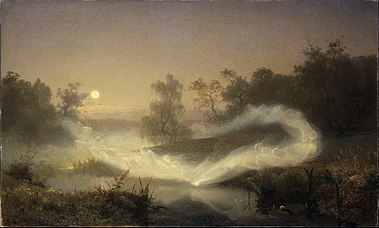
|
Dancing Fairies is an oil painting on canvas by the Swedish painter August Malmström (1829–1901). Completed in 1866 and drawing on Swedish folk tradition, it depicts fairies dancing above the water in a moonlit landscape. The painting is held at the Swedish National Museum in Stockholm. Painting: August Malmström
Recently featured:
|
February 7

|
A honeycomb is a mass of hexagonal prismatic wax cells built by honey bees in their hives to contain their larvae and stores of honey and pollen. Honey bees consume about 8.4 lb (3.8 kg) of honey to secrete 1 lb (0.5 kg) of wax. As such, many beekeepers attempt to conserve honeycombs where possible. Photograph: Waugsberg
Recently featured:
|
February 8

|
Issued during the German occupation of a small section of Iran during the Persian Campaign of World War I, this 1904 five Mark German Imperial Treasury note has been overstamped in Farsi with the denomination of 12 qiran 10 shahi for local circulation. This note is the smallest denomination in a five-note issue which included 25 qiran (overprinted on a 10 Mark note), 5 tomans (20 Mark), 25 tomans (100 Mark), and 250 tomans (1,000 Mark). Banknote: Germany (image courtesy of the National Numismatic Collection, National Museum of American History)
Recently featured:
|
February 9
|
La Silla Observatory is an astronomical observatory in Chile, some 150 kilometres (93 mi) northeast of La Serena. On this site, at the outskirts of the Atacama Desert, are three telescopes built and operated by the European Southern Observatory (ESO) as well as several other telescopes partly maintained by ESO. The observatory is one of the largest in the southern hemisphere and the first in Chile to be used by ESO. Photograph: ESO/F. Kamphues
Recently featured:
|
February 10

|
The Three Musicians is an oil painting by the Spanish Baroque painter Diego Velázquez (1599–1660). One of his earliest works, the painting depicts three young men around a dinner table playing music. It is painted in chiaroscuro, a Baroque technique that uses the contrast between light and darkness to achieve a sense of volume. The work is now held at the Gemäldegalerie in Berlin, Germany. Painting: Diego Velázquez
Recently featured:
|
February 11

|
Kitty Joyner (1916–1993) was an American electrical engineer with the National Advisory Committee for Aeronautics (NACA), and then the National Aeronautics and Space Administration (NASA). She was hired in 1939 as the organization's first woman engineer, shortly after she had become the first woman to graduate from the University of Virginia's engineering program. Photograph: NACA
Recently featured:
|
February 12

|
Scott Thwaites (born 1990) is a British cyclist and member of Team Qhubeka NextHash. He represented England in the 2014 Commonwealth Games road race, winning a bronze medal, and was named in the startlist for the 2016 Vuelta a España and 2017 Tour de France. He is shown here in the 2014 Tour of Britain. Photograph: Katie Chan
Recently featured:
|
February 13

|
The snowy owl (Bubo scandiacus) is a large, white owl of the typical owl family. Snowy owls are native to Arctic regions in North America and Eurasia. Males are almost all white (as seen here), while females have more flecks of black plumage. Juvenile snowy owls have black feathers until they turn white. The snowy owl is a ground nester that primarily hunts rodents and waterfowl and opportunistically eats carrion. Photograph: Michael Gäbler
Recently featured:
|
February 14

|
Venus Consoling Love is a painting completed by François Boucher in 1751. It depicts a mythological scene, where Venus, the goddess of love, is about to disarm Cupid by taking away his arrows. Venus is depicted as a young, charming, and supple woman, in accordance with French Rococo's beauty ideals. Once owned by Madame de Pompadour, the chief mistress of Louis XV, the painting is now in the collection of the National Gallery of Art in Washington, D.C. Painting: François Boucher
Recently featured:
|
February 15

|
Achillea millefolium is a flowering plant in the family Asteraceae. Native to temperate regions of the Northern Hemisphere in Asia, Europe, and North America, it has been introduced as a feed for livestock in New Zealand and Australia. In antiquity, this plant was used to stanch the flow of blood from wounds. Today, it is frequently cultivated as an ornamental plant in plant nurseries, although it is sometimes considered a weed. Photograph: Petar Milošević
Recently featured:
|
February 16

|
Borgund Stave Church, a triple-nave stave church of the Sogn type, is the best preserved of 28 stave churches extant in Norway. Located in the village of Borgund in Sogn og Fjordane, the church is part of the Borgund parish in the Indre Sogn deanery in the Diocese of Bjørgvin. No longer regularly used for church functions, it is now a museum run by the Society for the Preservation of Ancient Norwegian Monuments. Photograph: Simo Räsänen
Recently featured:
|
February 17

|
Nikolay Kovalev (R) attacks Áron Szilágyi (L) in the semi-finals of the men's sabre event at the 2013 World Fencing Championships. Although Kovalev won, he lost in the final against Veniamin Reshetnikov. Held in Budapest, Hungary, from 5 to 12 August, the 2013 Championships saw 827 fencers from 101 countries compete. Russia won the most medals (11), followed by Italy (6) and Ukraine (4). Photograph: Marie-Lan Nguyen
Recently featured:
|
February 18
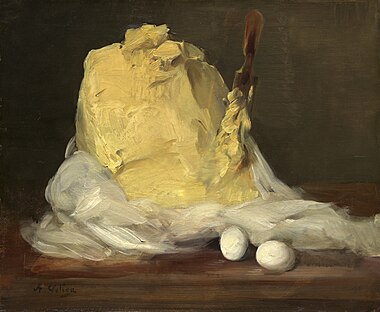
|
Mound of Butter is a painting by the French realist painter Antoine Vollon completed between 1875 and 1885. A still life, it depicts a mound of butter, coloured in rich, deep yellow, with thick marks after the artist's brushwork that may be intended to suggest the marks of a butter knife. The painting is held at the National Gallery of Art in Washington, D.C. Painting: Antoine Vollon (image courtesy of the National Gallery of Art)
Recently featured:
|
February 19
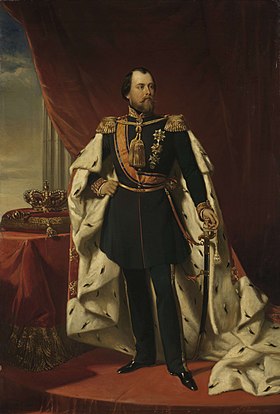
|
William III of the Netherlands (1817–1890) was the King of the Netherlands and Grand Duke of Luxembourg between 1849 and 1890. The son of King William II and Anna Pavlovna of Russia, William came to the throne after his father's death. During his reign, he instituted a new constitution in Luxembourg and considered selling that country to France. Painting: Nicolaas Pieneman
Recently featured:
|
February 20

|
A short-spined crown-of-thorns starfish (Acanthaster brevispinus) photographed at Malapascuas Island, Philippines. One of the two members of the starfish genus Acanthaster, this species was first described by the American zoologist Walter Kenrick Fisher from a specimen collected off Sirun Island. A. brevispinus is thought to be widely distributed, with specimens collected in the Philippines, the Great Barrier Reef, and the Seychelles. Photograph: Matt Kieffer
Recently featured:
|
February 21
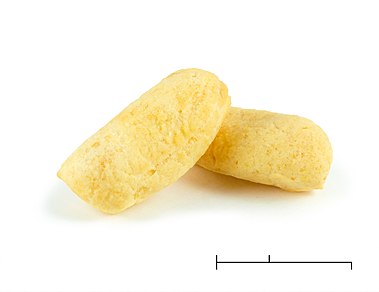
|
Amplang is a traditional savoury fish cracker snack commonly found in Indonesia and Malaysia. Amplang crackers are commonly made of ikan tenggiri (wahoo) or any type of Spanish mackerel, mixed with starch and other materials, and then fried. Their size and shape varies, from traditional elongated "tiger nails", to dice, to ping pong balls. The colour may range from yellow to light brown. The upper scale mark shows 1 cm while the lower one is 1 inch. Photograph: Chris Woodrich
Recently featured:
|
February 22

|
The Yellow House is an 1888 oil painting by the 19th-century Dutch Post-Impressionist painter Vincent van Gogh. It depicts 2 Place Lamartine, Arles, France, where Van Gogh rented four rooms in 1888, as well as a restaurant where he had his meals. This painting is now part of the permanent collection of the Van Gogh Museum in Amsterdam. Painting: Vincent van Gogh
Recently featured:
|
February 23

|
The Genesis Nomad is a handheld game console by Sega released in North America in October 1995. A portable variation of Sega's home console, the Sega Genesis, Nomad served to succeed the Game Gear and was the last handheld console released by Sega. In addition to functioning as a portable device, it was designed to be used with a television set via a video port. Released late in the Genesis era, the Nomad had a short lifespan and was sold exclusively in North America. Photograph: Evan Amos
Recently featured:
|
February 24

|
William H. Crawford (1772–1834) was an American politician and judge during the early 19th century. He served as United States Secretary of War and United States Secretary of the Treasury before running for president in the 1824 election. Born in Virginia, Crawford moved to Georgia at a young age and studied law. In 1803 he was elected to the Georgia House of Representatives, and in 1807 the Georgia legislature elected him to the United States Senate. Under President James Madison, he was made U.S. minister to France before taking several cabinet posts. Despite suffering a severe stroke in 1823, Crawford sought the presidency with the Democratic-Republican Party. As no candidate won a majority of the electoral vote, the United States House of Representatives selected John Quincy Adams as president from the three candidates who had received the most electoral votes. Crawford was then asked to remain at Treasury, but refused, and spent the last decade of his life as a judge of the Georgia state superior court. Engraving: Bureau of Engraving and Printing; restoration: Andrew Shiva
Recently featured:
|
February 25
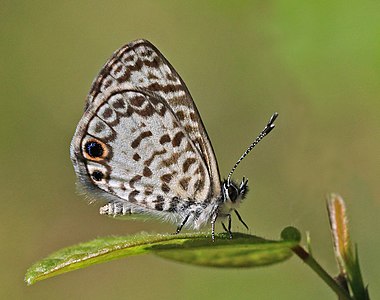
|
A Cassius blue butterfly (Leptotes cassius theonus) in Artemisa, Cuba. It is part of the family Lycaenidae, and is found from the southern United States through the Caribbean, Mexico, Central and South America. Caterpillars of this species are known to feed on such plants as the woolly rattlepod and lima bean. Photograph: Charles J. Sharp
Recently featured:
|
February 26

|
Mont Sainte-Victoire and the Viaduct of the Arc River Valley is an oil painting on canvas completed by the French artist Paul Cézanne between 1882 and 1885. It depicts Montagne Sainte-Victoire and the valley of the Arc River, with Cézanne's hometown of Aix-en-Provence in the background. Once owned by the art collectors and patrons Henry and Louisine Havemeyer, the painting was bequeathed to the Metropolitan Museum of Art in New York after the latter's death in 1929. Painting: Paul Cézanne
Recently featured:
|
February 27

|
All Saints, Margaret Street, is a Grade I listed Anglican church in London. Designed by the architect William Butterfield and built between 1850 and 1859, it has been hailed as Butterfield's masterpiece and a pioneering building of the High Victorian Gothic style that characterized British architecture from around 1850 to 1870. The church is particularly celebrated for its interior decoration, seen here. Every surface is richly patterned or decorated: the floor in diaper-patterned tiles; wall surfaces in geometrical patterned brick, tile, and marble, as well as tiles with painted decoration; large friezes executed in painted tiles; a painted ceiling; and painted and gilded timberwork behind the altar. Photograph: David Iliff |
February 28

|
Augusta Savage (1892–1962) was an African-American sculptor associated with the Harlem Renaissance. Much of her work is in clay or plaster, as she could not often afford bronze, and some—such as Lift Every Voice and Sing, created for the 1939 New York World's Fair—were destroyed for lack of funds. As a teacher, she promoted equal rights in art, and her studio was important to the careers of such artists as Gwendolyn Knight, Jacob Lawrence, and Norman Lewis. Photograph: Unknown; restoration: Yann |
Picture of the day archives and future dates

